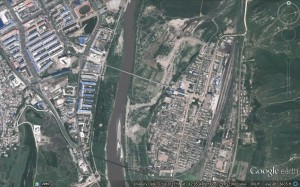Pictured above: Tumen China (left), Namyang, DPRK (Right)
According to Xinhua:
A border city in northeast China launched Friday bicycle tours to the neighboring Democratic People’s Republic of Korea (DPRK) as tourism to the country booms.
Thirty-five Chinese tourists joined the first self-drive travel by bicycle from Tumen City, Jilin Province, to DPRK’s Namyang city, said organizers. The tourists spent three hours in the DPRK.
The bicycle tour is inexpensive and only needs simple procedures, said an official of the Tumen Tourism Bureau. He said the route is expected to attract more tourists to the DPRK.
Excursions by train from Tumen to the DPRK’s Chilbosan resumed on Wednesday. The tourist train was launched in April 2012, but was later suspended.
Tumen has highway and railway service to the DPRK.
Xinhua also posted this story which offers more context:
Tourism to the Democratic People’s Republic of Korea (DPRK) is booming in northeast China border cities on the back of multiple travel schemes aimed at boosting the regional economy.
On Friday, Zhao Xin beamed with joy as he joined the first group of cyclists from Tumen City, Jilin Province, to DPRK’s Namyang city.
Tumen, under the jurisdiction of Yanbian, a Korean autonomous prefecture in Jilin, is separated from DPRK by the Tumen River. The cross-border city is linked with DPRK by highways and railways.
Amid high spirits, Zhao, a travel agent from Yanbian, was among thirty-five Chinese tourists in the DPRK, visiting the Namyang Railway Station, Kim Il-sun’ s statue, and enjoying local delicacies in a famous downtown street during a one-day visit.
“The city is quite unique and full of energy,” Zhao told Xinhua, hoping that more DPRK cities would join the list of the travel-by-bicycle initiative so that he could enjoy more sightseeing as well as the local gastronomical culture.
For Chen Boyi, taking a train is a splendid choice to tour the neighboring country. Chen said that her excursion during the Workers’ Day holiday helped unravel some mysteries of DPRK.
“Namyang is very clean and the local people warm-hearted,” Chen, 21, said.
Excursions by train from Tumen to the DPRK’s Chilbosan resumed two days before the bicycle tour program. The tourist train was launched in April 2012, but was later suspended.
The train and bicycle tours are the latest effort to ramp up the cross-border tourism.
In April, the city of Ji’an, Jilin, launched regular tourist trains to Pyongyang, Kaesong and Panmunjom in the DPRK, making it the second city after Dandong in the neighboring Liaoning Province with such services.
In 2013, Tumen city simplified applications for non-local visitors, allowing them to enter the DPRK on the same day they arrive in Tumen.
Meanwhile, the DPRK has opened several cities for group tours from China, including Rason, Namyang, Chongjin and the Mount Kumgang.
The schemes have powered the past few years of tourism boom. About 10,000 tourists from Yanbian alone visit the DPRK annually.
With a variety of travel means, it will be more convenient to visit the DPRK, said Ji Run, a tourist who has just wrapped a visit to the country.
“I would like to come back in the future,” he said.
Yonhap also reports:
North Korea and China have simplified border-crossing procedures for Chinese tourists traveling to the North, China’s state media reported Monday, in another sign that Pyongyang is eager to boost tourism income.
The move allows Chinese people who take tours from China’s border cities in Jilin and Liaoning provinces to get a “travel pass” to North Korea within 24 hours, compared with the previous two days, the state-run China Daily reported.
The report did not elaborate when the simplified procedures took effect, but North Korea started a new one-day tour program last week by opening its border to bicycle tourists from China for the first time.
The newspaper carried a photo of Chinese tourists entering North Korea by taking bicycles from the northeastern city of Tumen in Jilin province to the North Korean border city of Onsong.
Last week, China resumed train operations on a route from Tumen to the North’s northeastern port city of Chongjin, after a year of renovation, the report said.
Zhang Weidong, an official at a Chinese travel agency responsible for the train travel, told the newspaper that more than 2,000 tourists used the train in 2012 before the renovation.
“The number is estimated to rise to 7,000 this year,” Zhang said.
The four-day train trip to North Korea costs about 1,900 yuan (US$304), the report said.
North Korea is one of the world’s most secretive and isolated nations, but since last year, Pyongyang has stepped up efforts to attract foreign tourists, including offering more international and domestic flights.
Read the full stories here:
Chinese city launches bicycle tours to DPRK
Xinhua
2014-5-2
N. Korea, China simplify border-crossing for Chinese tourists
Yonhap
2014-5-5

